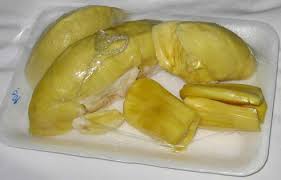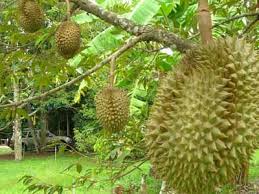DURIAN 2
 The durian, native to Brunei, Indonesia and Malaysia, has been known to the Western world for about 600 years. The 19th-century British naturalist Alfred Russel Wallace famously described its flesh as "a rich custard highly flavoured with almonds". The flesh can be consumed at various stages of ripeness, and it is used to flavour a wide variety of savoury and sweet edibles in Southeast Asian cuisines. The seeds can also be eaten when cooked.
The durian, native to Brunei, Indonesia and Malaysia, has been known to the Western world for about 600 years. The 19th-century British naturalist Alfred Russel Wallace famously described its flesh as "a rich custard highly flavoured with almonds". The flesh can be consumed at various stages of ripeness, and it is used to flavour a wide variety of savoury and sweet edibles in Southeast Asian cuisines. The seeds can also be eaten when cooked.
There are 30 recognised
Durio species, at least nine of which produce edible fruit.
Durio zibethinus is the only species available in the international market: other species are sold in their local regions. There are hundreds of durian
cultivars; many consumers express preferences for specific cultivars, which fetch higher prices in the market.
 |
| durian flesh and jack fruit packed together for sale |
Durian
trees are large, growing to 25–50 metres (80–165 ft) in height depending on the species. In Malaysia the durian stems are processed and properly treated to become furniture woods. The demands for durian woods for furniture is high and there are very big prospects for the durian woods to be widely accepted as a good furniture wood.

The leaves are
evergreen, elliptic to oblong and 10–18 centimetres (4–7 in) long. The flowers are produced in three to thirty clusters together on large branches and directly on the trunk with each flower having a calyx (
sepals) and five (rarely four or six)
petals. Durian trees have one or two flowering and fruiting periods per year, though the timing varies depending on the species, cultivars, and localities. A typical durian tree can bear fruit after four or five years. The durian fruit can hang from any branch and matures roughly three months after
pollination. Among the thirty known species of
Durio, nine of them have been identified as producing edible fruits:
D. zibethinus,
D. dulcis,
D. grandiflorus,
D. graveolens,
D. kutejensis,
D. lowianus,
D. macrantha,
D. oxleyanus and
D. testudinarum. However, there are many species for which the fruit has never been collected or properly examined, so other species with edible fruit may exist. The durian is somewhat similar in appearance to the
jackfruit, an unrelated species.
No comments:
Post a Comment